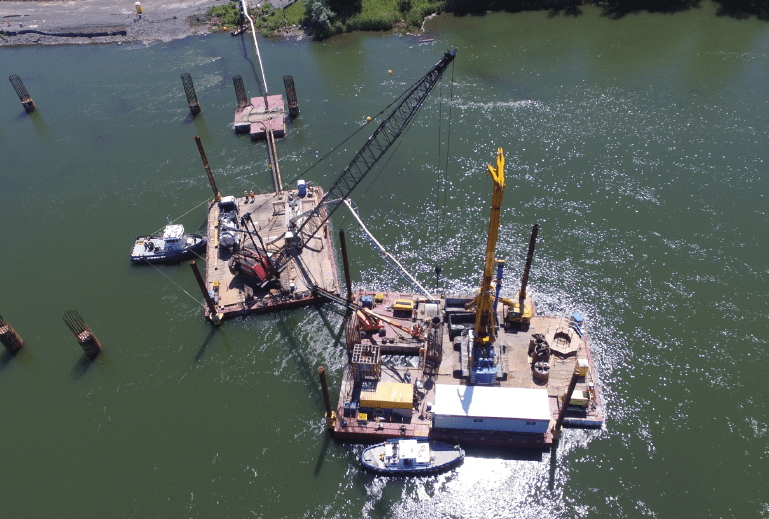
Built at a cost of approximately $4 billion, the new Champlain Bridge in Montreal, Que., will officially open in June 2019, marking the end of the one of the largest infrastructure projects undertaken in Canada.
It replaces an existing federally-owned bridge built in 1962 that’s become one of the busiest spans in North America. Some 50 million cars, trucks and buses make the crossing over the Saint Lawrence Seaway every year, leading to considerable wear and tear on the old bridge and high maintenance costs which helped drive the decision to build a new one.
Like its predecessor (which was named for the founder of Québec City, Samuel de Champlain), the new cable-stayed bridge represents a vital link in a major transportation corridor for the shipment of cross-border goods between Canada and the United States. The new Champlain Bridge is expected to be used by up to 60 million motor vehicles a year and it’s projected to have a service life of 125 years.
The new bridge features two three-lane corridors for vehicular traffic as well as a two-lane transit corridor capable of accommodating a planned light rail transit system. It also includes a multi-use lane for pedestrians and cyclists.
BAUER Foundations Canada Inc. was instrumental in the deep foundation work for the project, installing concrete piles for the new 3.4-kilometre-long Champlain Bridge as well as another smaller bridge, a 470-metre span to L’Île-des-Soeuers or Nuns’ Island which is located in the St. Lawrence River.
The company was awarded a $16-million piling contract by Signature on the St. Lawrence Construction, an international consortium of companies that includes Montreal-based SNC-Lavalin, the Spanish firm Dragados, and Colorado-based Flatiron Construction. Piling operations began in October of 2015 and the work was completed in July 2016.
Allan Bowers is operations manager for BAUER Foundations Canada. Bowers oversaw his company’s involvement in the new Champlain Bridge project and says the client was very happy with the job performed by BAUER. “Our element of the work went exactly as planned,” he said, “This is something that hopefully we can continue to excel in as we engage in these large-scale, complicated projects around the world.”
BAUER Foundations Canada initially mobilized two drilling rigs for the Champlain Bridge job – a BAUER BG 28 and a BG 40 – to install the piles. The original BG 40 on site was later replaced by a new BAUER Premium Line BG 39 in January 2016.
A total of 200 rotary bored piles were installed, with 190 piles drilled from land or jetties. The remainder were marine piles drilled from barges. The piles had diameters of 1,300 and 2,000 millimetres and ranged in length from 10 to 24 metres.
Project challenges
According to Bowers, there weren’t any issues involving safety, the environment and quality, but a number of challenges did arise with the piling work that needed to be dealt with. Working from a floating barge in the middle of the St. Lawrence River to install the 2,000-millimetre concrete piles, for example, proved one of the more challenging aspects of the project, Bowers says, and it required detailed planning and co-ordination with the client and other crews on the job site.
A number of special measures were required to pull this off, including changing the geometry of the barges to allow for safe and efficient drilling. The stability of the barges was also carefully checked for all conceivable construction scenarios and contingencies, with adjustments made if necessary.
As concrete needed to be pumped in from onshore facilities during the marine pile construction, it was also necessary to adjust the concrete mix to account for the long pumping lines that were required during this process.
Bowers says three barges were utilized during the piling portion of the project, “a crane barge, a drill barge and a service barge to take the equipment out to us.” He adds the depth of the water where the piling crews were working in the St. Lawrence River was fairly shallow. “This meant that maneuvering the barges had to be done a certain way, and that presented some challenges,” Bowers said.
Companies involved in the new Champlain Bridge project were required to comply with rigorous environmental monitoring and mitigation measures to protect the surrounding natural environment.
One of the measures employed by BAUER Foundations Canada was using vegetable oil rather than hydraulic oil in the company’s equipment on site to lessen the environmental impact if a spill did occur. “We were in some cases working on the river, so there was a huge emphasis on avoiding any issues there,” Bowers said.
BAUER Foundations Canada, which had 20 people working on the job site at peak of construction, started the project with two crews on a day shift. The company added a third night shift crew during November and December of 2015 to meet the client’s schedule. Bowers says one unique aspect of the new Champlain Bridge project involved ground conditions. In addition to bedrock, the BAUER piling crews encountered a variety of underlying soils ranging from sand, silt and shale. They also came across glacial till, with hard intrusive igneous dykes and sills running through some of the till layers.
“The rock strength was quite variable, and it was quite strong in some places, but there weren’t any major issues,” said Bowers.
According to Bowers, strict criteria were implemented for cleaning the base of each pile bore before it was installed. For example, the thickness of sediment or loose, disturbed material covering the pile toe could not exceed 15 millimetres and airlifting was carried out to remove debris for the pile bores. This was followed by camera inspection before the concrete was finally pumped in.
Bowers says all of the piles on the new Champlain Bridge project underwent quality control testing using either thermal integrity profiling or crosshole sonic logging, which verifies the structural integrity of drilled shafts.